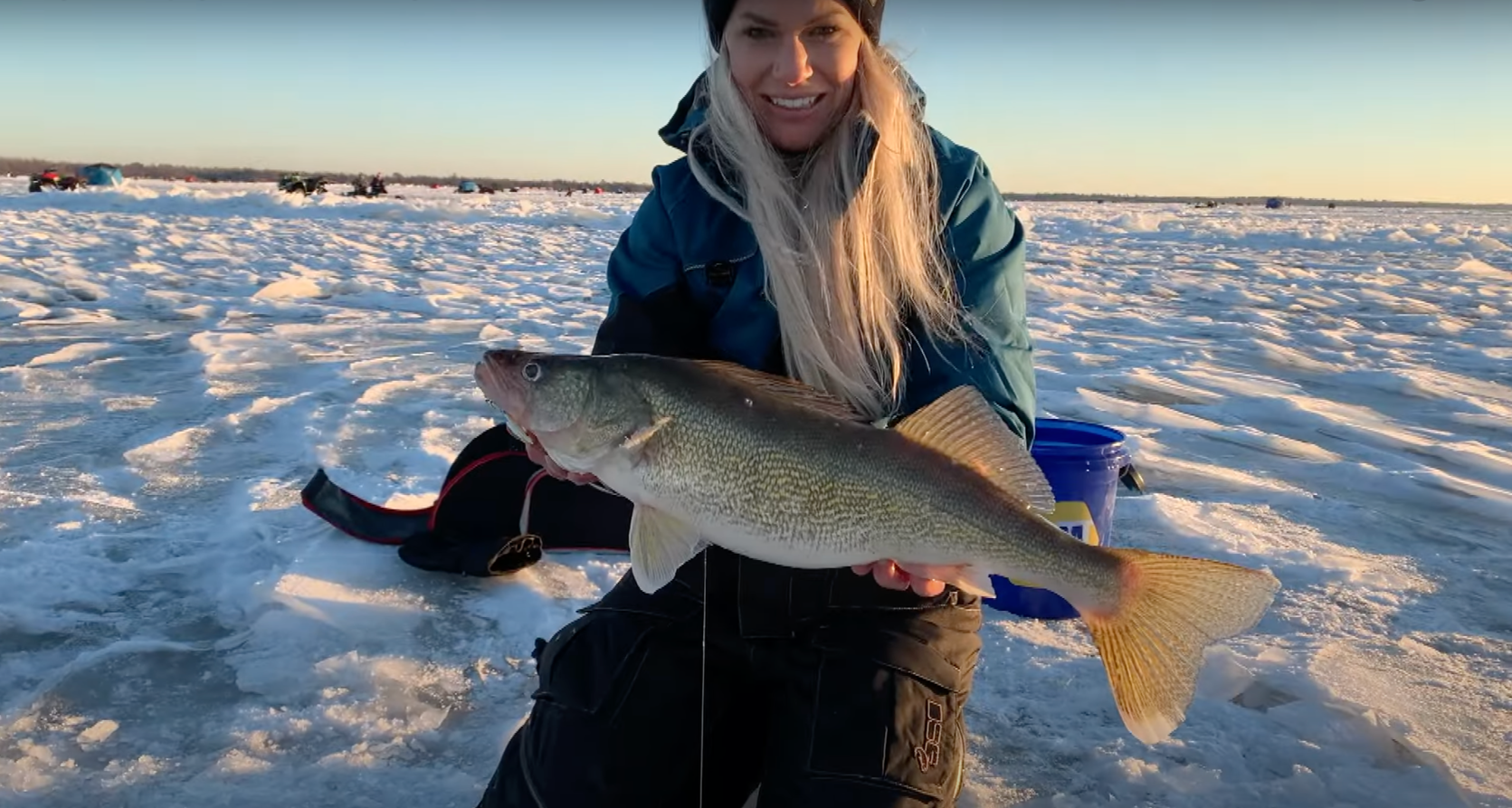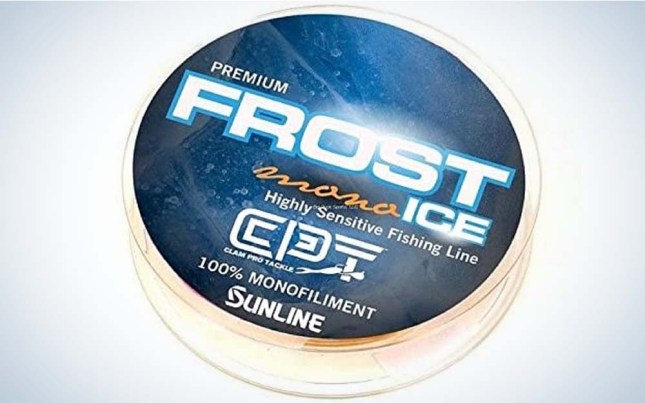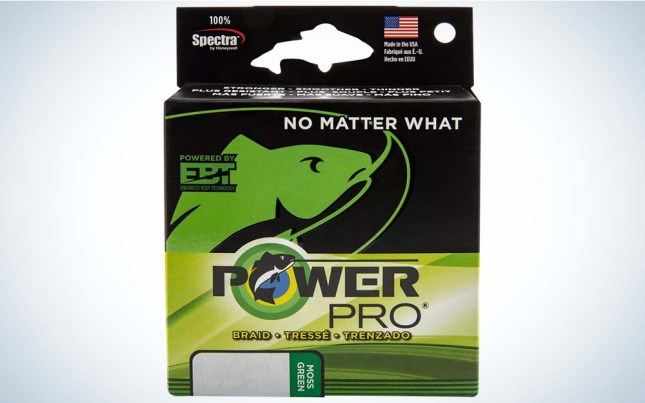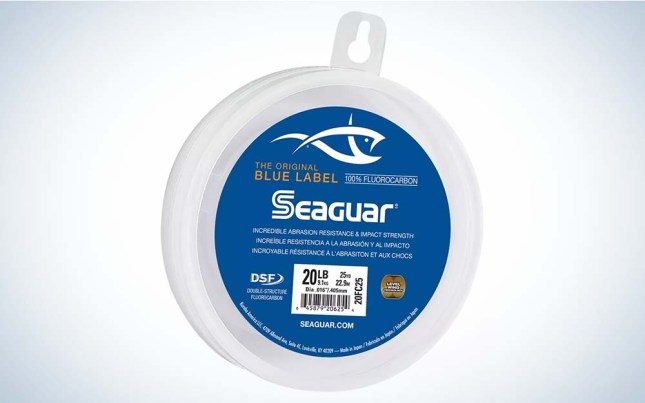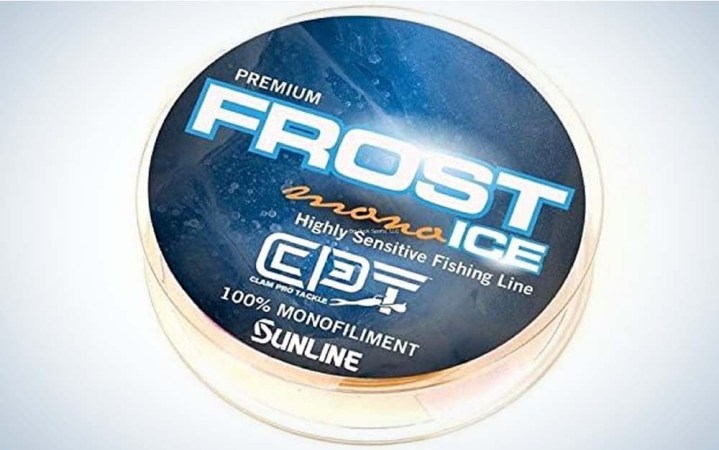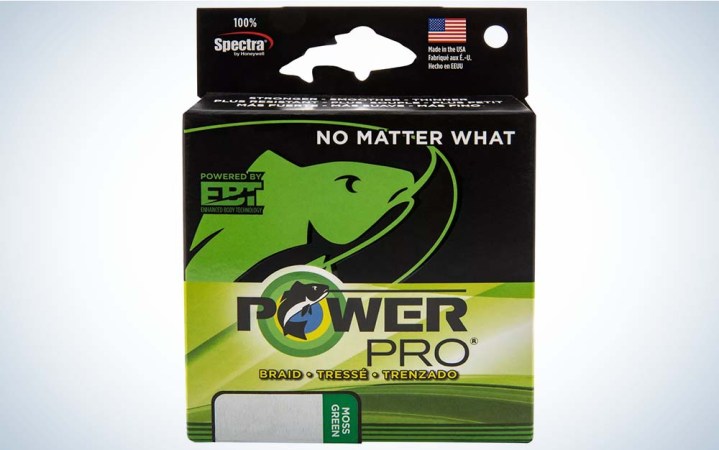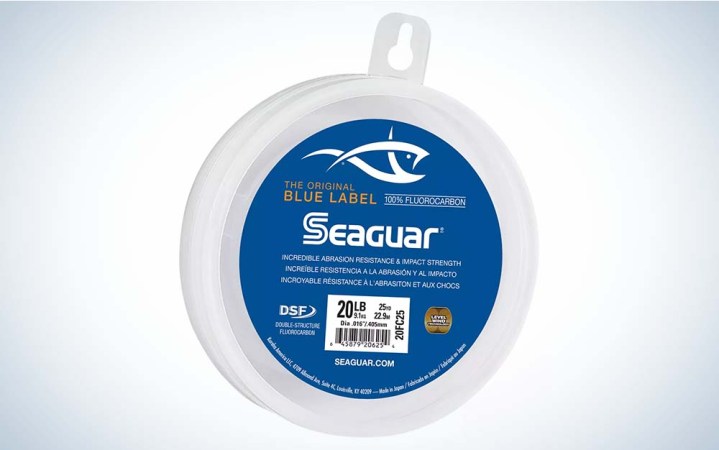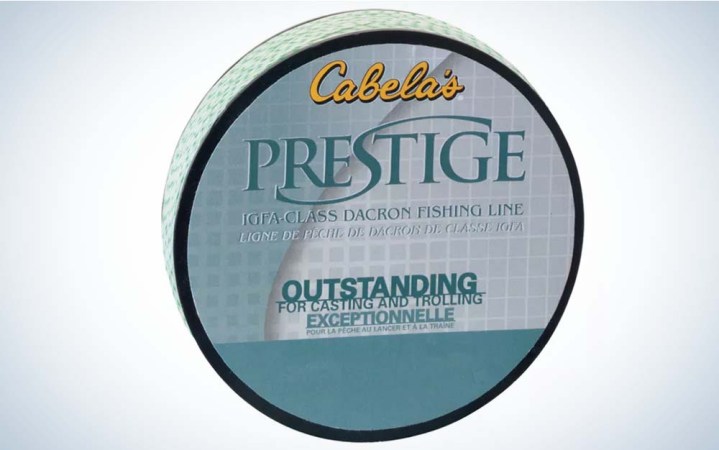We may earn revenue from the products available on this page and participate in affiliate programs. Learn More ›
It’s no secret that using the best ice fishing line is critical for any setup. Whether it’s jigging for panfish or using tip-ups for pike, the cold water and hostile environment will push your line to its limits. Having the right line will make or break your chance at landing that trophy fish.
Choosing the proper line can be complicated. There are multiple different kinds, with different properties, that are all used with different applications. Learning when and where to use each type takes a combination of knowledge and experience. That’s why I’ve created the below guide to help you better understand the best ice fishing lines and their properties.
- Best for Panfish: Clam CPT Frost Monofilament
- Best for Walleye and Pike: PowerPro Braided Fishing Line
- Best for Fluoro Leaders: Seaguar Blue Label Fluorocarbon Leader
- Best for Tip-Ups: Cabela’s Prestige Braided Dacron
How to Choose the Best Ice Fishing Line
Choosing the right line for ice fishing requires understanding the different line types and how they differ in a variety of factors, including:
- Visibility
- Knotting
- Memory
- Stretch
- Sensitivity
- Abrasion
- Resistance
- Line icing
- Cost
Matching your line to the situation is essential when making your selection. To do that, you need first to understand the basic properties of the three most popular types of fishing lines: monofilament (mono), fluorocarbon (fluoro), and braided line (braid).
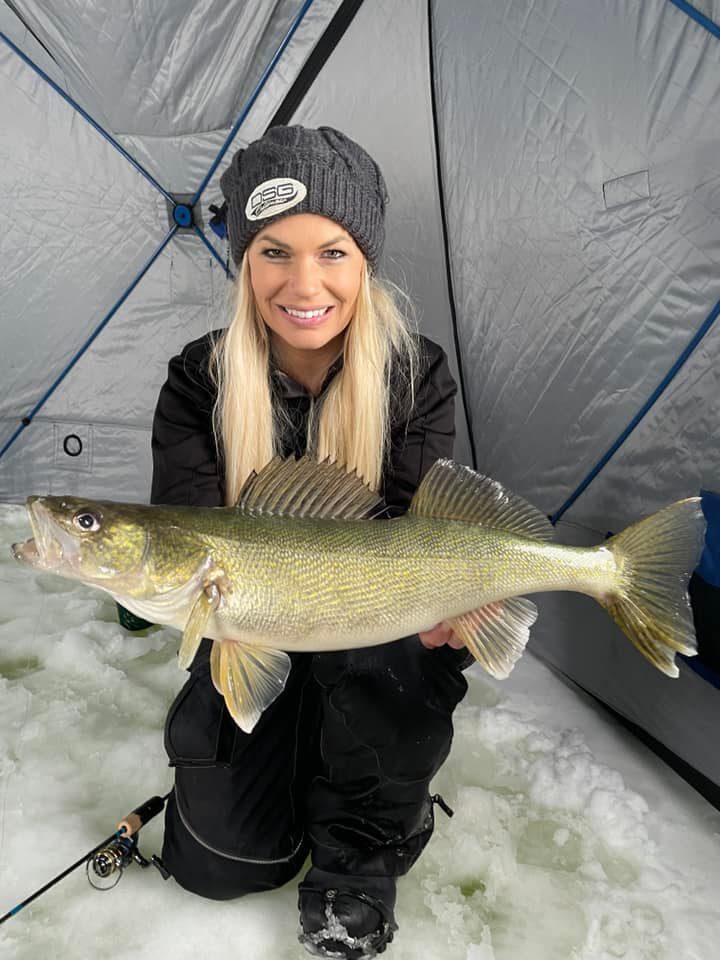
Visibility
Visibility is how detectable the line is underwater. Fluoro is the most invisible, followed by mono, and then by braid, which is going to be the most visible. This means when dealing with ultra-clear water, or lineshy fish, it is recommended to use either fluorocarbon line or a fluorocarbon leader.
When using a fluoro leader, anglers often use braid for the main line. This way you get the flexibility and sensitivity of braid without compromising fluoro’s invisibility. In almost all clear water situations I will cut 3 or 4 feet of fluorocarbon line to use as a leader.
Line Memory
If you’ve ever pulled line off an old reel and the line came off all curled up, you saw the effects of line memory. Mono and fluoro—especially mono—have the most memory. When spooled and stretched, these lines have a tendency to “remember” that shape which causes them to coil when spooled off the reel. This can drastically reduce line performance and sensitivity while also causing your lure to spin. For tough bites and low movement presentations, this spin can turn a lot of fish away. On the other hand, braid has no memory, and coiling is not an issue.
Stretch
Mono has the greatest stretch, followed by fluoro, which is stiffer but has some give. Braid, on the other hand, has almost no stretch. Braid’s lack of stretch increases sensitivity and helps with hooksets when fishing in deep water.
But sometimes, stretch is a good thing. The stretch provides the line with “give” to cushion hooksets and hard runs. Because of this, I find monofilament works well in finesse bluegill and crappie situations. Here, having extra stretch helps mask the tension of the line and makes them less apt to spit out the bait before you can set the hook.
Abrasion Resistance
Fluoro has the best abrasion resistance and slips along edges, making it an excellent leader option. Sharp teeth and ice much more easily cut mono and braid, and they tend to cut into and get caught up on rough edges at the bottom of the ice hole more often. When looking to avoid these situations, abrasion resistance will be your best friend.
Water Absorption
Braid absorbs water which causes your rod eyelets and reel to freeze up quickly. This is obviously a big deal when ice fishing in the elements. The only upside of braid during the ice season is that it makes for easy ice removal. Mono and fluoro are not absorbent and usually take longer to freeze up. However, they can be a serious pain to thaw out when they do freeze.
Price
Fluoro is usually the most expensive line option, followed by braid and monofilament. Of course, this is dependent on brand and quality, but generally speaking, mono will be the easiest on the wallet, and fluoro is best used as a leader if you want to save bucks.
Best Ice Fishing Lines: Reviews & Recommendations
Best for Panfish: Clam CPT Frost Monofilament
Key Features
- Low visibility
- Stretches but has low memory compared to many other monofilament lines
- 1- to 8-pound test
- Available in clear, gold, red/clear, and gold/clear
- Doesn’t lose strength or suppleness in the cold
Pros
- Excellent knot strength
- Adequate stretch for panfish
- High sensitivity for monofilament line
- Excellent shock resistance
Cons
- Still a monofilament line that can cause twists
- Cut easily by sharp teeth and ice edges
- Less sensitivity than fluorocarbon or braid
Clam CPT Frost Monofilament is considered one of the best ice fishing lines for panfish. It excels at working with finesse lures and detecting light bites, and it also has an excellent shock resistance that reduces the chance of the fish spitting the hook or ripping the lure out of paper-thin panfish lips. The Clam CPT Frost is also durable, easy to knot, and highly versatile, making it an excellent choice for beginners and seasoned anglers alike. I find Clam CPT Frost Mono best for jigging panfish because it is highly sensitive compared to other monofilament lines, making it great for ultra-light lures. The 3- to 4-pound test options are my picks for various panfish applications and provide excellent bite detection while also being able to handle the occasional walleye or pike.
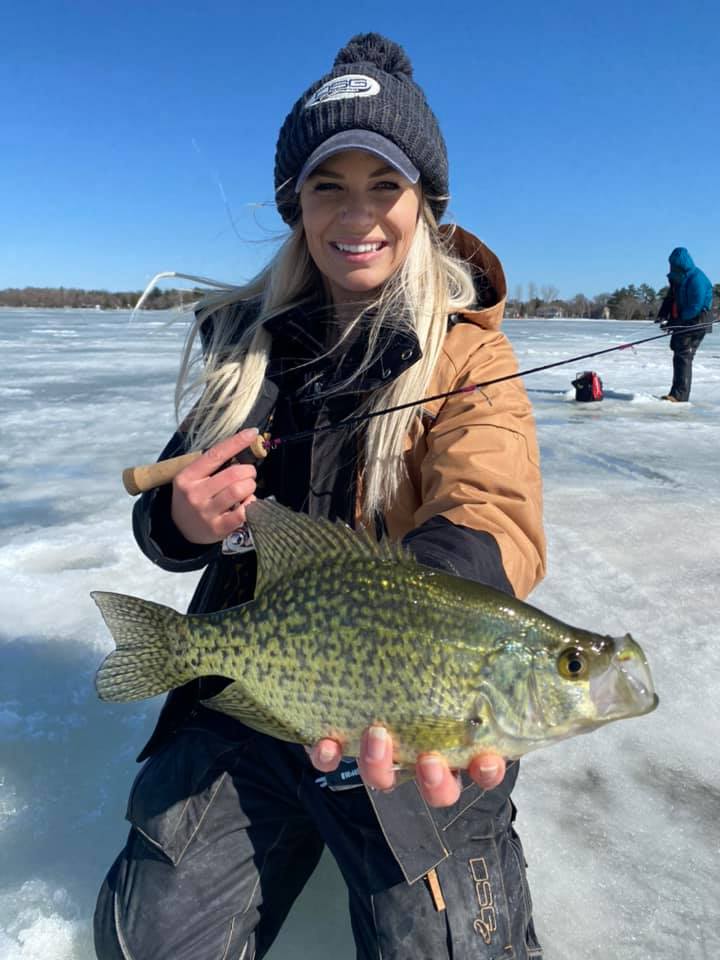
The limited stretch of Frost Mono (when compared to other mono) provides an ideal hookset while also allowing ample forgiveness for those wild panfish runs. Mono has the most stretch of any line, but this shock resistance works incredibly well for panfish. The stretch helps eliminate the tension and bait detection. It also ties easily, making swapping out lures styles and colors a breeze, which can be critical on tough bite days and for beginner anglers. Like all mono, its memory will cause some line twists and require you to change out your line every so often to prevent your lure from spinning and keep those finesse presentations still underwater. However, it’s generally the least expensive of all the line options making line changes a bit more affordable.
Best for Walleye and Pike: PowerPro Braided Fishing Line
Key Features
- 5- to 80-pound test
- Colors: Moss Green and Hi-Vis Yellow
- No stretch
- High strength
- Sensitive
- Absorbs low moisture compared to competitive braid
Pros
- No line memory
- Very sensitive and responsive
- Runs smoothly on the reel
- Versatile
- Strong
- Wide range of weights for various applications
- Easy ice removal
Cons
- Very visible in the water, especially at higher weights
- Low shock resistance
- Absorbs water and can freeze (but better than most braids)
- Low abrasion resistance
Known for its strength and high sensitivity, braided line is a common go-to for most walleye and pike fishing applications, and PowerPro makes some of the best. PowerPro Braided line is available in a variety of poundage, so whether you’re after panfish, pike, sturgeon, or even something larger you’ll find something to suit your needs. It comes in various colors including moss green, vermillion red, and hi-vis yellow (making bites easily detectable). For targeting walleye, I like to use 8- to 10-pound test and upsize to target larger pike. Braid is more visible, so I often pair it with a fluorocarbon leader.
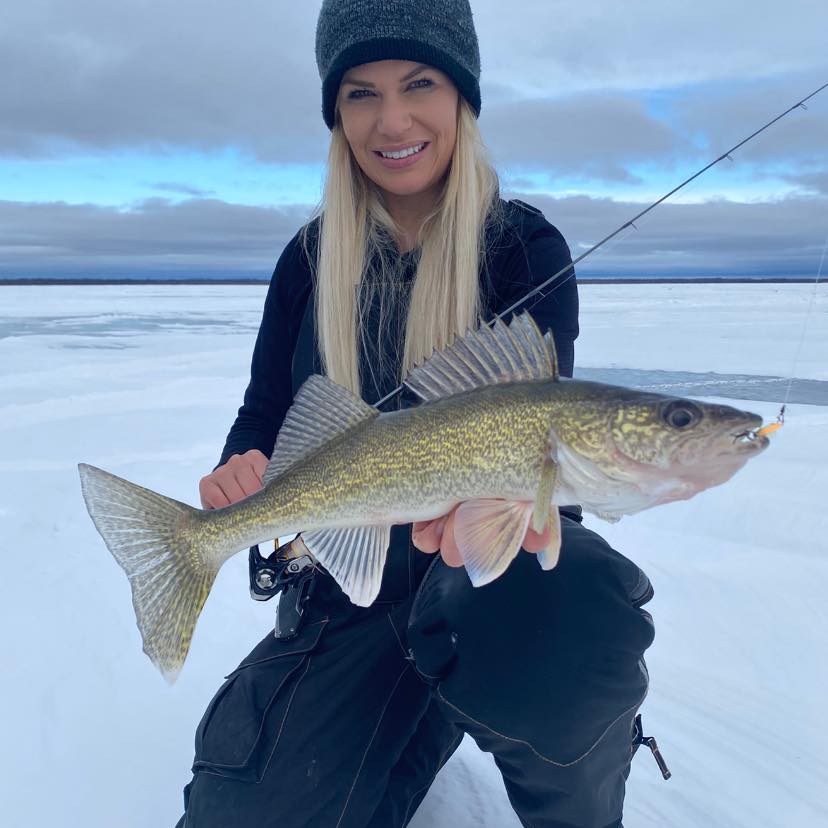
Braid’s strength, lack of stretch, and great sensitivity make this braid great for jigging deep water for large fish. Also, pay attention to your drag. Braid can quickly snap, so playing your drag is key to battling those bigger fish.
Braid does collect ice quickly. However, it’s the easiest of the lines to remove ice from. Simply grab the line and slide your hand down the ice build up, and you’ll find it flies off quickly.
Best for Fluoro Leaders: Seaguar Blue Label Fluorocarbon Leader
Key Features
- Nearly invisible in water
- Low plasticity stays stretched once deformed
- UV resistant
- Chemical resistant
- Low moisture absorbant
- High-density
Pros
- Less visible underwater than mono
- Less memory than mono reduces line twisting
- Sinks faster than braid and mono
- Very abrasion resistant
Cons
- Can be difficult to tie
- Lower knot strength than mono or braid
- Cold temps can stiffen the line and cause it to unspool
Fluoro is used primarily for its lack of visibility. However, it’s not its only benefit. The abrasion resistance of fluoro makes it great for leaders which often come into contact with the razor-sharp teeth of predator fish and the edge of the ice hole. Seaguar’s Blue Label Fluorocarbon Leader is one of the best at this. It’s as invisible as it gets underwater, and the stiffness allows control of your presentation and allows for excellent bite detection. Seaguar’s Blue Label Fluoro Leader line is made from 100% Seaguar resins with their proprietary extrusion process. It’s available in an enormous array of weights (2 to 80 pounds) that allows it to be used for just about any application. For walleye jigging, I recommend a couple of feet of 10- to 12-pound test at the end of any braided line.
I like to tie directly from braid to fluoro with a double uni knot, but you can also use a swivel to make things easier. If you make your own quick-strike rigs for pike fishing, go with a 40- to 60- pound weight and use a small barrel swivel to help control the line twist that often happens on with tip-ups. It is on the pricey side, but its use as a leader allows a spool of line to go a long way.
Best for Tip-Ups: Cabela’s Prestige Braided Dacron
Key Features
- 20- to 130-pound test
- Color: Green/white
- High-tensile strength
- Abrasion-resistant
- Minimal stretch
- Maximum knot strength
Pros
- Doesn’t tangle easily
- Very strong and durable
- Easy to hand-line and fight big fish
- Available in heavier weights
Cons
- Absorbs water and can freeze
- Can bite into the ice and get stuck
- Higher visibility
When hand-lining your catch on a tip-up, Dacron is easy to grab and doesn’t instantly turn into a tangled mess. This line can withstand a lot of abrasion from large fish circling or running parallel to the surface and rubbing the line against the bottom of your hole. Sharp teeth also cut through this heavy-duty line less often, making it essential for anyone targeting trophy pike. Although the Cabela’s Prestige Dacron soaks up water and can freeze easily when moving between fishing locations, you can pull it to break it free from a frozen spool without worrying about snapping the line. Classic uncoated black Dacron line is hard to beat when it comes to fishing with tip-ups. You could also run a coated Dacron line like Suffix V-Coat. The coated line works well and freezes up less, but it has more stretch and memory to deal with, making it challenging to hang baits horizontally.
When I use Dacron line I like a heavier test—30 to 60 pounds. It find it works best not only for rolling off the spool smoothly but also for handling the line easier when fighting a trophy-sized fish. The thicker diameter of heavier test also bites less into the ice at the bottom of the hole. Be sure to pair it with heavy-duty tackle. For pike, a good recommendation is to tie on a heavy-duty swivel at the end and attach a quick-strike tandem treble hook rig. Steel or titanium leaders are common on pre-made rigs, but making your own with a heavy-duty fluorocarbon leader can give you a more invisible presentation to help improve your catch rate without sacrificing much in the way of strength and durability.
FAQs
Hi-vis line is good for detecting bites, but it should be paired with a clear mono or flouro leader.
Ice fishing lines need to withstand freezing temperatures and they also must be able to be abrasion resistant. But, like regular lines one type of ice fishing line won’t cover you for all scenarios. Ice anglers use dacron, mono, braid, and fluoro for different applications.
A low-stretch mono works well for ice fishing for panfish. A fluorocarbon line is best to use as a leader when using a braid main line.
Final Thoughts
There is no one-size-fits-all fishing line when it comes to ice fishing. In fact, you can catch fish on any line, but if you want to improve your catch rate, make the most of your rods and tackle, and spend less time trying and more time catching, then educating yourself on line becomes essential.
- Best for Panfish: Clam CPT Frost Monofilament
- Best for Walleye and Pike: PowerPro Braided Fishing Line
- Best for Fluoro Leaders: Seaguar Blue Label Fluorocarbon Leader
- Best for Tip-Ups: Cabela’s Prestige Braided Dacron
